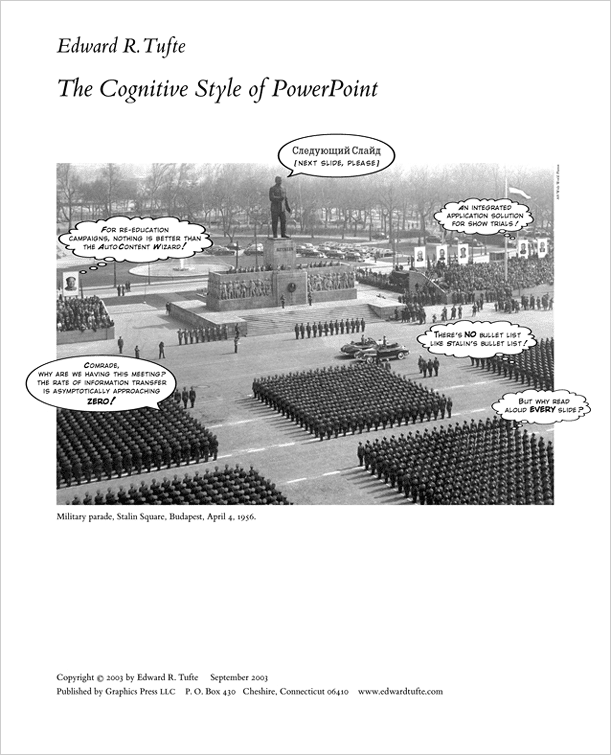|
|
THE COGNITIVE STYLE OF POWERPOINT Edward R. Tufte Graphics press LLC, 2003, 27 pp. ISBN 0-9613921-5-0 www.edwardtufte.com |
|
Edward
Tufte is a former professor of statistics and analytical design at Yale. He writes, designs and publishes his own
books on analytical design. This
essay is a scathing critique of PowerPoint.
“Some methods of presentation are better than others. And PowerPoint is rarely a good method.”
(26) Using farcical slides as well as
real-life examples, he illustrates how PowerPoint weakens presentations of
scientific data, risk assessment, and strategic planning. Slides
often reduce the analytical quality of presentations. The ready-made designs usually weaken
verbal and spatial reasoning and almost always corrupt statistical analysis.
(3) “PowerPoint
is entirely presenter-oriented, and not content-oriented, not
audience-oriented.” The cognitive
style of standard default templates is faulty. It results in “foreshortening evidence and thought, low spatial
resolution, a deeply hierarchical single path structure as the model for
organizing every type of content, breaking up narrative and data into slides
and minimal fragments, rapid temporal sequencing of thin information rather
than focused spatial analysis, conspicuous decoration and Phluff, a
preoccupation with format not content, an attitude of commercialism that
turns everything into a sales pitch.” (4) “Many
true statements are too long to fit on a PP slide, but this does not mean we
should abbreviate the truth to make the words fit. It means we should find a better way to make presentations.”
(4) A slide says “Correlation is not
causation.” This is misleading in
that while correlation does not prove causation, it is a necessary condition
and a good hint. Bullet
lists leave critical relationships unspecified. They communicate only sequence, priority or membership in a
set. They ignore and conceal the
causal assumptions and analytic structure of the reasoning. Sentences with
subjects and verbs are usually better. (5-6) Tufte
shows three PowerPoint presentations used by NASA officials to report the
in-flight risk assessment of the damage to the ill-fated Challenger. His critique of the over-optimistic
assessment is crushing. The reports
used standard PP formats with bullet outlines, segregation of words and
numbers, cryptic typography, etc. The
PowerPoint information hierarchy mimicked the hierarchical structure of the
bureaucracy that produced it. “The
choice of headings, arrangement of information, and size of bullets on the
key chart served to highlight what management already believed.” (10) “PowerPoint
will not do for serious presentations.
Serious problems require serious tools.” (11) A
picture can communicate much more than a thousands words and much more
quickly. However, “nearly all
PowerPoint slides that accompany talks have much lower rates of information
transmission than the talk itself.
Too often the images are content-free clip art, the statistical
graphics don’t show data, and the text is grossly impoverished.” “The PowerPoint slide typically shows 40
words, which is about 8 seconds-worth of silent reading material.” (12) “A
vicious circle results. Thin content
leads to boring presentations. To
make them unboring, PPPhluff is added, damaging the content, making the
presentation even more boring....”
For serious presentations replace slides with handouts showing words,
numbers, data graphics and images together.
“Thin visual content prompts suspicions: ‘What are they leaving
out? Is that all they know? Does the speaker think we’re stupid?’ ‘What are they hiding?’” (12) The
metaphor behind the PP cognitive style is the software corporation and
program writing “(deeply hierarchical, nested, highly structured,
relentlessly sequential, one-short-line-at-a-time) and marketing (fast pace,
misdirection, advocacy not analysis, slogan thinking, branding, exaggerated
claims, marketplace ethics).” (13) A
better metaphor for presentations is good teaching, exhibiting the
core ideas of “explanation, reasoning, finding things out, questioning,
content, evidence, credible authority not patronizing authoritarianism....”
(13) The
actual text of the Gettysburg Address is set next to six hilarious PowerPoint
slides representing it. My favorite
is the chart showing in two columns the number of new nations: -87 years, 1;
now, 0. (You know, “Four score and
seven years ago...”) The
use of PowerPoint with medical data and statistical information is critiqued
on pp. 16-21. “The
PP slide format has probably the worst signal/noise ration of any known
method of communication on paper or computer screen.” (22) “Sometimes
quick chunks of thin data may be useful (flash-card memorizing), other times
not (comparisons, links, explanations).
But formats, sequencing, and cognitive approach should be decided by
the character of the content and what is to be explained, not by the
limitations of the presentation technology.” (23) “Presentations
largely stand or fall depending on the quality, relevance, and integrity of
the content. The way to make big
improvements in a presentation is to get better content.” (24) [However, we
all know that presentation skills are also very important. Dlm] “Audience
boredom is usually a content failure, not a decoration failure. At a minimum, a presentation format should
do no harm to content.” (24) “The
practical conclusions are clear.
PowerPoint is a competent slide manager and projector for
low-resolution materials. And that’s
about it.” (24) “Never
use PP templates for arraying words or numbers. Avoid elaborate hierarchies of bullet lists. Never read aloud from slides. Never use PP templates to format paper
reports or web screens. Use PP as a
projector for showing low-resolution color images, graphics, and videos that
cannot be reproduced as printed handouts at a presentation.” “Thoughtfully planned handouts at your
talk tell the audience that you are serious and precise; that you seek to
leave traces and have consequences.
And that you respect your audience.” (24) “PP
has a distinctive, definite, well-enforced, and widely-practiced cognitive style
that is contrary to serious thinking.
PP actively facilitates the making of lightweight presentations.” (26) ******** |
|
